 Sofie Lundberg is senior content marketing and social media executive at GlobalWebIndex
Sofie Lundberg is senior content marketing and social media executive at GlobalWebIndex
In unprecedented times, behaviors fluctuate dramatically – partly because mindsets are changing fast.
Consumers become worried about new things, more risk-averse, more alert. Their aspirations and hopes for the future change, as do the things they value and hold closest to their hearts.
And while most leading businesses have long understood the value of unique insight into their target audiences’ attitudes, interests and thought processes, it has never been more important to look deeper into your consumer’s changing mindset.
Why psychographic needs more focus in advertising
Focusing on consumer opinions, feelings and motivations, psychographic data brings demographic research to life. Without it, you know who your consumers are, but not why they do the things they do.
From a global pandemic to civil upset, the United States is seeing massive change at the moment, and with this comes new and evolving ways of thinking and perceiving.
Our new GWI USA data set offers fresh insight into the modern American consumer, through which we can analyze consumers using more than 600 psychographic data points. Looking under the lens of advertising, some interesting truths come to light.
For instance, only 9 percent of Americans say they feel represented in the advertising they see.
For an industry in which the sole focus is to reach – and resonate with – your audience, this points to a huge disconnect between brands and the consumers that they are trying to reach. Looking closer at U.S. consumers under a multicultural lens, here is what we see:
- Only 11 percent of African Americans and 7 percent of Asian Americans feel represented in advertising.
- A fifth of Asian Americans and a quarter of Hispanic Americans say they prefer ads that reflect their culture.
- Thirty-one percent of African Americans prefer ads that reflect their culture.
Insight such as this offers clear direction on the kind of advertising and messaging U.S. consumers want – which is exactly what advertisers need in uncertain and unprecedented times.
Now let us look at what’s on the minds of American consumers more broadly in the midst of major change.
What is on the minds of today’s U.S. consumers?
1. Corporate social responsibility is key for engaging them
Consumers in 2020 demand more of their favorite brands than great products or services – their one most important request is that they take social responsibility.
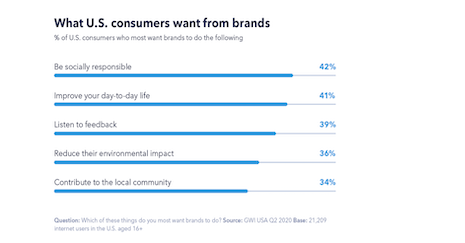 What U.S. consumers want from brands. Source: GlobalWebIndex
What U.S. consumers want from brands. Source: GlobalWebIndex
2. The majority would vote Democrat were there an election tomorrow
Ahead of Republican at 26 percent, 36 percent of U.S. consumers would vote Democrat at the moment. But 11 percent are still unsure where their vote would go.
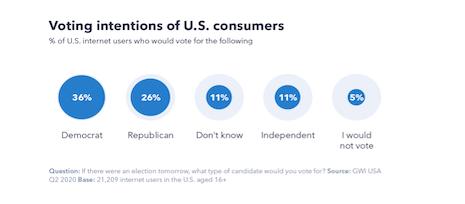 Voting intentions of U.S. consumers. Source: GlobalWebIndex
Voting intentions of U.S. consumers. Source: GlobalWebIndex
3. Viruses top the list of worries
Ahead of fears such as terrorism, gun violence, and climate change, health is at the forefront of U.S. consumers’ minds.
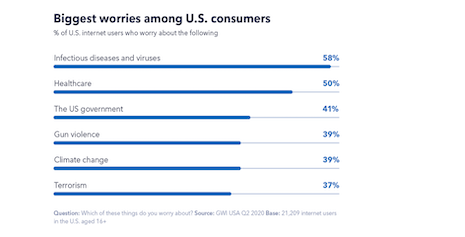 Biggest worries among U.S. consumers. Source: GlobalWebIndex
Biggest worries among U.S. consumers. Source: GlobalWebIndex
This is also reflected in the question on their current hopes and aspirations, where health comes out top on 59 percent – ahead of being happy (52 percent) and being financially secure (47 percent).
4. More than a quarter see their personal finances negatively
Nine percent of Americans say they are “struggling” with their personal finances. But it is not all bad news – more than a third describe themselves as “comfortable.”
 Financial perspectives among U.S. consumers. Source: GlobalWebIndex
Financial perspectives among U.S. consumers. Source: GlobalWebIndex
5. Health is top of mind for the future
Not surprisingly, Americans are focusing on their health in 2020. This comes in ahead of aspects such as happiness and money.
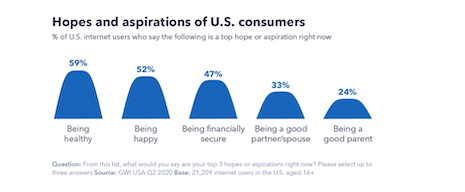 Hopes and aspirations of U.S. consumers. Source: GlobalWebIndex
Hopes and aspirations of U.S. consumers. Source: GlobalWebIndex
Regional spotlight: Californian consumers
By delving deeper into the data, you can get a more targeted view of your consumer. As an example, here is an exploration of Californian consumers compared to the rest of the U.S.
The average Californian is:
- 37 percent more likely to identify as atheist
- 33 percent more likely to describe themselves as vegan
- 23 percent more likely to eat food from delivery services regularly
- 22 percent more likely to take a vacation in a different country every six months
- 21 percent more likely to describe their political views as liberal
- 12 percent more likely to say they’re worried about climate change
Let us dive even deeper and compare Californian baby boomers and Gen Z.
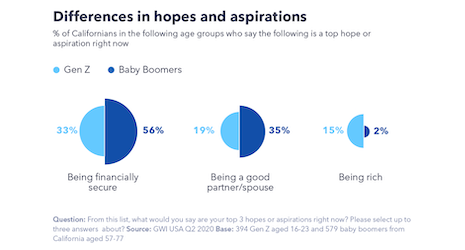 Differences in hopes and aspirations. Source: GlobalWebIndex
Differences in hopes and aspirations. Source: GlobalWebIndex
 Differences in fears and worries. Source: GlobalWebIndex
Differences in fears and worries. Source: GlobalWebIndex
Moving forward with psychographic data
We know as we venture further into the “next normal,” old strategies will no longer resonate with consumers that are facing new challenges.
With less than 10 percent of Americans feeling represented in the advertising they see, there is a clear and problematic divide between how brands and consumers think.
TO MOVE WITH the mindsets of U.S. consumers, the way brands use psychographic must change to match. Here is how to get started.
- Revisit your audience segments and personas.
- Look as far ahead as possible.
- Tell emotionally compelling, but culturally sensitive, stories.
- Keep coming back to refreshed, attitudinal research and adapt alongside.
Sofie Lundberg is senior content marketing and social media executive at GlobalWebIndex.
